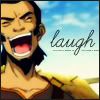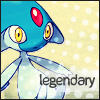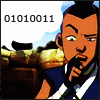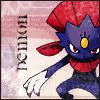Vibrant Color Tutorial
You're ready to create an icon but you're not certain where to begin. You have all the brushes, text, masks, and borders to make any icon out there but coloring has to be done first. In this tutorial we'll be going step by step from preparing an image to turning it into a base and then a simple finished icon. We'll turn this into this. The coloring we'll be using can be used on just about any scan, screen cap, and photograph out there with bright colors and blue sky in the background. This works especially well on those brightly colored animation screen caps. In the end, you'll have a wonderful vibrant coloring that you can use as a part of any icon you want. This tutorial was written using Photoshop CS but can be translated to any program that includes Hard Light layer settings, Brightness/Contrast adjustments, and Hue/Saturation adjustments.


Our first step will be to get a decent image to work with. Taking your original image, select the amount you want to appear in your icon. When working with watermarked caps and scans it is best to end the selection box either right before or above the network or website logo. Go to the Edit or Image menu in your graphics program and select Crop. Using your program's image resizing option set the image height to 120px. Now is the time to smooth your subject's skin with the blur tool in your graphics program if needed. You are now ready to prep your image.

Next we will begin to prep the working image we created. Sharpen your image if needed. Duplicate the image and set it to Hard Light at a 100% opacity. We want the image soft but not too soft so we go to the Guassian Blur filter and set the radius to either 0.5 or 1px. For this icon the radius was set to 1px .

Our image looks good but the color could use a bit of a boost. To do this we'll create two adjustment layers (Photoshop). The first adjustment to the color will come from a Brightness/Contrast layer. Set your contrast to +9. It's not much but it will make a difference in the end. The second adjustment to the color will come from a Hue/Saturation layer. Set your Saturation to +16 and your Lightness to +10. Always preview your image before hitting okay. If the color looks washed out after setting the lightness change your number until it looks lighter and brighter. For most images +5 works well.

It's time to create your icon base. Use CTRL + A to select your image and copy a merged image by merging the layers or selecting Copy Merge in the Edit menu (Photoshop). Paste your image onto a new 100x100 canvas and move it around until your subject is where you like it. Merge the image with the canvas to create your base. This is the base that was used for this icon.

Here is where we will begin to create our final icon color. We want to soften the colors slightly. Create a new layer and fill it with #00041D . Set the layer type to Exclusion and leave the opacity at 100%. It's not much of a visible difference but the colors are softer than they were.

The colors look good but we want to lighten them slightly. On a new layer you want to fill it with #011172 . Set the layer type to Soft Light and keep the opacity at 100%. If the icon looks a bit dark you can always reduce the opacity until it looks satisfactory. The goal is to get the color where you want it to be. Remember no two images will act the same.

Our color looks good but sometimes the subject's skin, the clouds in the sky, and images in the background could stand to be a bit more skin-like or darker. To achive this we're going to fill a new layer with #FDF2C4. Set the layer type to Multiply. The layer looks muddy so we'll fix that by setting the opacity anywhere between 30% to 45%. For this icon the opacity was set to 35%.

The coloring looks good but it lacks that soft vibrant pop we want to achieve. To do this duplicate your base and bring it to the top of your icon layers.To achieve the softness in our coloring select the Guassian Blur filter and set it to a pixel radius of 1.5. Set the layer type to Soft Light and leave the opacity at 100%. Our coloring is now complete and the icon is ready for further manipulation, brushes, and text. I chose to add a few final details to the icon.

I wanted to add a little text to the icon in a simple script font. For this icon I chose Learning Curve from Dafont.com. The font color is set to #1E1E1E while the size is set at 30pt due to the small size of the font. I then typed in "laugh" and moved it around my negative space until it was in a good position.

With the text in a good position I decided to dress it up with a tiny text brush. I opened a new layer under my text layer and began playing around with my tiny text brushes. Not happy with the results I had been getting I decided to modify a small tiny text font to fit the text. I took a brush from sanami276 on DA and placed it twice under the text on both sides of the "G" in laugh. Then I erased the bottom half to creat a broken line under my text.

Happy with my results, I merged all my layers and hit CTRL + A to select the icon. I then created a 1px border in the same #1E1E1E color as the text and brush. In Photoshop this can be achieved by hitting Stroke in the Edit menu. The pixels are set to one and the position is set at center. In Paint Shop Pro the same effect can be achieved by drawing a one pixel wide box around the icon or using 99x99 selection box and expanding it 1 pixel in the same color. Happy with how it looks I call it a finished icon and save it for future use or icon batches. Remember, what you do after you color your icon is entirely up to you. This coloring is a starting point for your wonderful icon results.
Credits:
Original Cap: Avatar: The Last Airbender Book 2 Chapter 5 at avatarspirit.net
Tiny Text Brush: sanami276 of fangirls_inc
Other Icons Using This Coloring:





Our first step will be to get a decent image to work with. Taking your original image, select the amount you want to appear in your icon. When working with watermarked caps and scans it is best to end the selection box either right before or above the network or website logo. Go to the Edit or Image menu in your graphics program and select Crop. Using your program's image resizing option set the image height to 120px. Now is the time to smooth your subject's skin with the blur tool in your graphics program if needed. You are now ready to prep your image.

Next we will begin to prep the working image we created. Sharpen your image if needed. Duplicate the image and set it to Hard Light at a 100% opacity. We want the image soft but not too soft so we go to the Guassian Blur filter and set the radius to either 0.5 or 1px. For this icon the radius was set to 1px .

Our image looks good but the color could use a bit of a boost. To do this we'll create two adjustment layers (Photoshop). The first adjustment to the color will come from a Brightness/Contrast layer. Set your contrast to +9. It's not much but it will make a difference in the end. The second adjustment to the color will come from a Hue/Saturation layer. Set your Saturation to +16 and your Lightness to +10. Always preview your image before hitting okay. If the color looks washed out after setting the lightness change your number until it looks lighter and brighter. For most images +5 works well.

It's time to create your icon base. Use CTRL + A to select your image and copy a merged image by merging the layers or selecting Copy Merge in the Edit menu (Photoshop). Paste your image onto a new 100x100 canvas and move it around until your subject is where you like it. Merge the image with the canvas to create your base. This is the base that was used for this icon.

Here is where we will begin to create our final icon color. We want to soften the colors slightly. Create a new layer and fill it with #00041D . Set the layer type to Exclusion and leave the opacity at 100%. It's not much of a visible difference but the colors are softer than they were.

The colors look good but we want to lighten them slightly. On a new layer you want to fill it with #011172 . Set the layer type to Soft Light and keep the opacity at 100%. If the icon looks a bit dark you can always reduce the opacity until it looks satisfactory. The goal is to get the color where you want it to be. Remember no two images will act the same.

Our color looks good but sometimes the subject's skin, the clouds in the sky, and images in the background could stand to be a bit more skin-like or darker. To achive this we're going to fill a new layer with #FDF2C4. Set the layer type to Multiply. The layer looks muddy so we'll fix that by setting the opacity anywhere between 30% to 45%. For this icon the opacity was set to 35%.

The coloring looks good but it lacks that soft vibrant pop we want to achieve. To do this duplicate your base and bring it to the top of your icon layers.To achieve the softness in our coloring select the Guassian Blur filter and set it to a pixel radius of 1.5. Set the layer type to Soft Light and leave the opacity at 100%. Our coloring is now complete and the icon is ready for further manipulation, brushes, and text. I chose to add a few final details to the icon.

I wanted to add a little text to the icon in a simple script font. For this icon I chose Learning Curve from Dafont.com. The font color is set to #1E1E1E while the size is set at 30pt due to the small size of the font. I then typed in "laugh" and moved it around my negative space until it was in a good position.

With the text in a good position I decided to dress it up with a tiny text brush. I opened a new layer under my text layer and began playing around with my tiny text brushes. Not happy with the results I had been getting I decided to modify a small tiny text font to fit the text. I took a brush from sanami276 on DA and placed it twice under the text on both sides of the "G" in laugh. Then I erased the bottom half to creat a broken line under my text.

Happy with my results, I merged all my layers and hit CTRL + A to select the icon. I then created a 1px border in the same #1E1E1E color as the text and brush. In Photoshop this can be achieved by hitting Stroke in the Edit menu. The pixels are set to one and the position is set at center. In Paint Shop Pro the same effect can be achieved by drawing a one pixel wide box around the icon or using 99x99 selection box and expanding it 1 pixel in the same color. Happy with how it looks I call it a finished icon and save it for future use or icon batches. Remember, what you do after you color your icon is entirely up to you. This coloring is a starting point for your wonderful icon results.
Credits:
Original Cap: Avatar: The Last Airbender Book 2 Chapter 5 at avatarspirit.net
Tiny Text Brush: sanami276 of fangirls_inc
Other Icons Using This Coloring:

